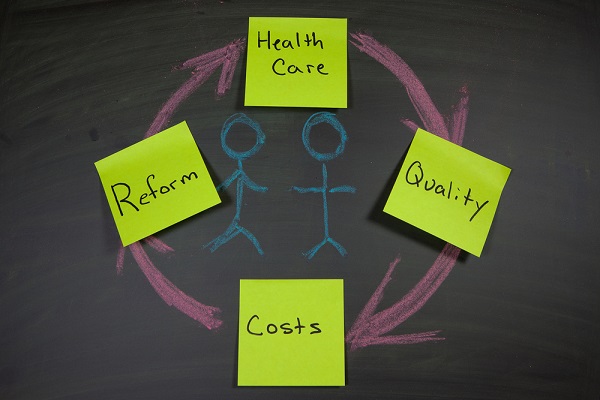 The Democratic presidentialdebate on Oct. 15 gives 12 of the candidates a fresh chance to talkabout their ideas beyond sprawling health care reform.
The Democratic presidentialdebate on Oct. 15 gives 12 of the candidates a fresh chance to talkabout their ideas beyond sprawling health care reform.
If you tuned in for the first five nights of the Democraticpresidential debates, you might think "Medicare for All" and providing universal careare the only health care ideas Democrats have.
|With four months to go before the Feb. 3 Iowa caucuses,proposals on issues like the opioid epidemic have attracted lessattention.
|That is because big-ticket policy ideas ― like enrolling allU.S. residents into a Medicare-style program and eliminatingprivate insurance ― can help candidates stand out in the eyes ofvoters during a primary, said RobertBlendon, a professor of health policy and political analysis atHarvard University and director of the Harvard Opinion ResearchProgram.
|Related: 5 Democratic presidential candidates' comments onhealth care reform
|But Blendon said he has not seen polling suggesting voters havean appetite for another major health care debate. Voters are moreconcerned with how much they have to pay for medical care, likeprescription drugs ― "very practical, pocketbook issues," hesaid.
|"So it's just my belief that whoever wins is going to have toswitch back to pocketbook issues," Blendon said of the eventualDemocratic nominee.
|A new poll echoes that. Democratic voters are eager to hear morefrom the candidates about other health care issues, according to aKaiser Family Foundation poll released Tuesday. The resultsshow 58 percent of Democrats and Democratic-leaningindependents believe the candidates are not spending enough timetalking about women's health, including access to reproductivehealth services, for instance. And more than half said thecandidates were spending too little time discussing surprisemedical bills and ways to lower the costs people pay for care. (KHNis an editorially independent program of the foundation.)
|The next Democratic presidential debate on Oct. 15 will give 12of the candidates a fresh chance to talk about their ideas beyondsprawling health care reform. Let us walk you through a fewproposals they have championed, plus what President Donald Trump isoffering.
|Sanders' plan to cancel medical debt
Sen. Bernie Sanders of Vermont rolled out a sweeping proposallast month to overhaul medical debt collection with aheadline-catching promise: to wipe clean the roughly $81 billionAmericans owe in past-due medical debt.
|And the issue is ubiquitous since polls show voters are deeplyconcerned about their out-of-pocket costs. RaymondKluender, an assistant professor at Harvard Business School whoresearches medical debt, said about 20 percent ofhouseholds have medical bills in collections.
|Kluender said Sanders' plan targets debt that is rarely repaidanyway, noting that only about 8 percent of what is sent tocollection agencies is ever repaid. Although some limited researchsuggests debt forgiveness may have mental health benefits, Kluendersaid, the effect Sanders' move would have "is hard to know."
|Here are highlights of Sanders'proposal:
- Empower the federal government to negotiate, then pay offpast-due medical bills that have been reported to the creditagencies. To calculate how much that debt is, the Sanders campaignpoints to a 2018 study that showed 1 in every 6 Americans has a past-duemedical bill on their credit report, with debt totaling about $81billion.
- Curb "abusive and harassing" debt collection tactics, includingenforcing statutes of limitation that generally run from three tosix years, depending on the state; limiting how often debtcollectors can contact those who owe; requiring debt collectors toverify whether the information they have is accurate beforeattempting to collect; restricting the seizures of assets andgarnishing of wages.
- Task the Internal Revenue Service with examining nonprofithospitals to ensure they meet the "charitable care standards" forfacilities with nonprofit tax status. Reform the bankruptcy courtsystem to help those in debt.
Biden's plan to curb gun violence
Former Vice President Joe Biden announced a plan this month toreduce gun violence, an issue that has become a must for most Democratic voters.
|In addition to outlining his proposal to ban the manufacture andsale of assault weapons and require universal background checks,Biden took the opportunity to talk about his legislative history onguns: In 1993, he helped pass the law that established thebackground check system, and in 1994, he helped secure the 10-yearassault weapons ban that has since lapsed.
|He also drew attention to his newer ideas to change the system,including a push toward transitioning to "smart guns."
|But Biden's plan does not go as far as that of some of hisopponents ― including Sen. Cory Booker (N.J.), who would require alicense to own a firearm.
|Here is whatBiden has said he would do on guncontrol:
- Ban the manufacture and sale of assault weapons andhigh-capacity magazines, and otherwise regulate and buy backexisting weapons.
- Require background checks for all sales, and close certainloopholes, including those that allow people with mental healthissues and hate crime convictions to have firearms.
- Reward states that set up firearm licensing programs, requireowners to safely store their weapons, and crack down on "strawpurchasers" who buy firearms for those who cannot pass a backgroundcheck.
Buttigieg's plan to strengthen mental health care
Mayor Pete Buttigieg of South Bend, Ind., introduced awide-ranging, $300 billion proposal in August to improve treatmentfor mental health and substance abuse.
|Few disagree on the need to increase access to mental healthcare in the United States, making the issue one that is unlikely tomove voters on its own, Blendon said. But Buttigieg's plan standsout for tripling the investments proposed by other Democraticcandidates, including Massachusetts Sen. Elizabeth Warren.
|True to his mayoral roots, Buttigieg adopts a locally drivenapproach. Among other strategies in his 19-page plan, he would give communities "most affected" bymental illness and addiction $10 billion annually for 10 years toaddress prevention and care.
|His campaign claims the plan would enable about 10 million morepeople to access care over the first four years of the program.Here are some ways Buttigieg said he would do that:
- Enforce mental health parity in coverage, including underMedicare and Medicaid.
- Expand access to addiction treatments, including byderegulating buprenorphine, a medication-assisted treatment proveneffective for opioid use disorder.
- Reduce related incarceration, in part by decriminalizing alldrug possession and expunging past convictions.
- Hold drug companies "accountable" for their role in the opioidepidemic, including by supporting state-level lawsuits.
- "Combat the epidemic of social isolation and loneliness,"including through a national service program that would pair olderand younger Americans.
Warren's plan to end the opioid crisis
Warren unveiled an aggressive plan to combat the nationwideopioid epidemic last spring, proposing to spread $100 billionacross the country to help state, local and tribal governmentsrespond to the crisis.
|And unlike Buttigieg and his $300 billion mental health andaddiction plan, Warren outlined how she would pay for it ― with atax on the richest 75,000 families.
|"This crisis has been driven by greed, pure and simple," shewrote in a Medium post detailing her plan.
|Here is some of what her plan woulddo:
- Prioritize and allocate money for public health departments,first responders and others in "front-line" communities.
- Give states incentives to cover addiction services throughstate Medicaid programs.
- Expand surveillance, research and access to treatment,including naloxone, the overdose reversal drug.
Trump's efforts on Medicare, public health and drug price
President Donald Trump caused a stir this year when he declaredthe Republican Party would become "the party of health care" andsuggested he was working on another proposal to replace theAffordable Care Act.
|But he has said little on the subject since then, and a Washington Post report last month said the White House hasabandoned that effort in favor of damage control should the 5thCircuit Court of Appeals strike down the Affordable Care Act.
|Instead, the Trump administration has picked up on a series ofoften disparate health issues, including changes to how thegovernment pays for care, investments in public health crises andsteps intended to pressure drugmakers to lower prices.
|One of his latest moves came on Oct. 3, when Trump signed an executive order making a variety of changes toMedicare, including expanding the private Medicare Advantage plansavailable to seniors and changing the enrollment process. He tookthe opportunity to pan the progressive push toward a single-payerhealth care system as "socialist," framing his changes asprotections for seniors.
|In addition to an ambitious plan to end HIV/AIDS introduced in February, theTrump administration unveiled a kidney care initiative in July thatadjusts payment incentives to encourage preventive care, homedialysis and transplants. And last month, the administration saidit was preparing to ban the sale of flavored e-cigarettes amid apublic health scare over vaping and concerns about widespread useamong teens.
|And after promising to lower drug prices, Trump has struggled to make changes amid disagreements with thepharmaceutical industry and even fellow Republicans.
|The administration has tasked the Department of Health and HumanServices to work on other policies, including requiring hospitalsto disclose prices and laying out a framework to allow, for the first time, the legalimportation of prescription drugs from overseas.
|KaiserHealth News is a nonprofit news service coveringhealth issues. It is an editorially independent program of theKaiser Family Foundation, which is not affiliated with KaiserPermanente.
Read more:
Complete your profile to continue reading and get FREE access to BenefitsPRO, part of your ALM digital membership.
Your access to unlimited BenefitsPRO content isn’t changing.
Once you are an ALM digital member, you’ll receive:
- Critical BenefitsPRO information including cutting edge post-reform success strategies, access to educational webcasts and videos, resources from industry leaders, and informative Newsletters.
- Exclusive discounts on ALM, BenefitsPRO magazine and BenefitsPRO.com events
- Access to other award-winning ALM websites including ThinkAdvisor.com and Law.com
Already have an account? Sign In
© 2024 ALM Global, LLC, All Rights Reserved. Request academic re-use from www.copyright.com. All other uses, submit a request to [email protected]. For more information visit Asset & Logo Licensing.








